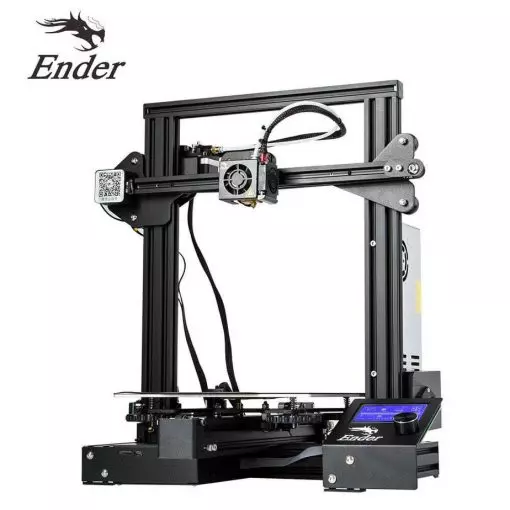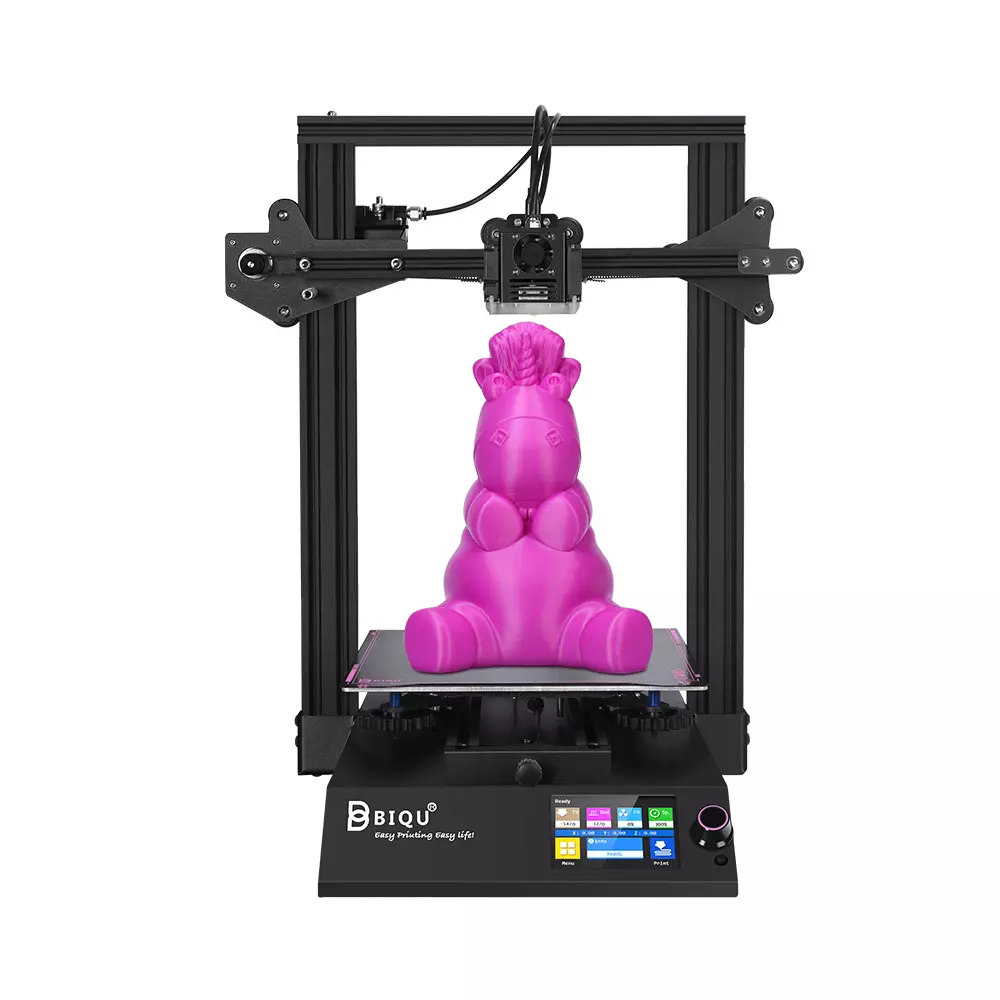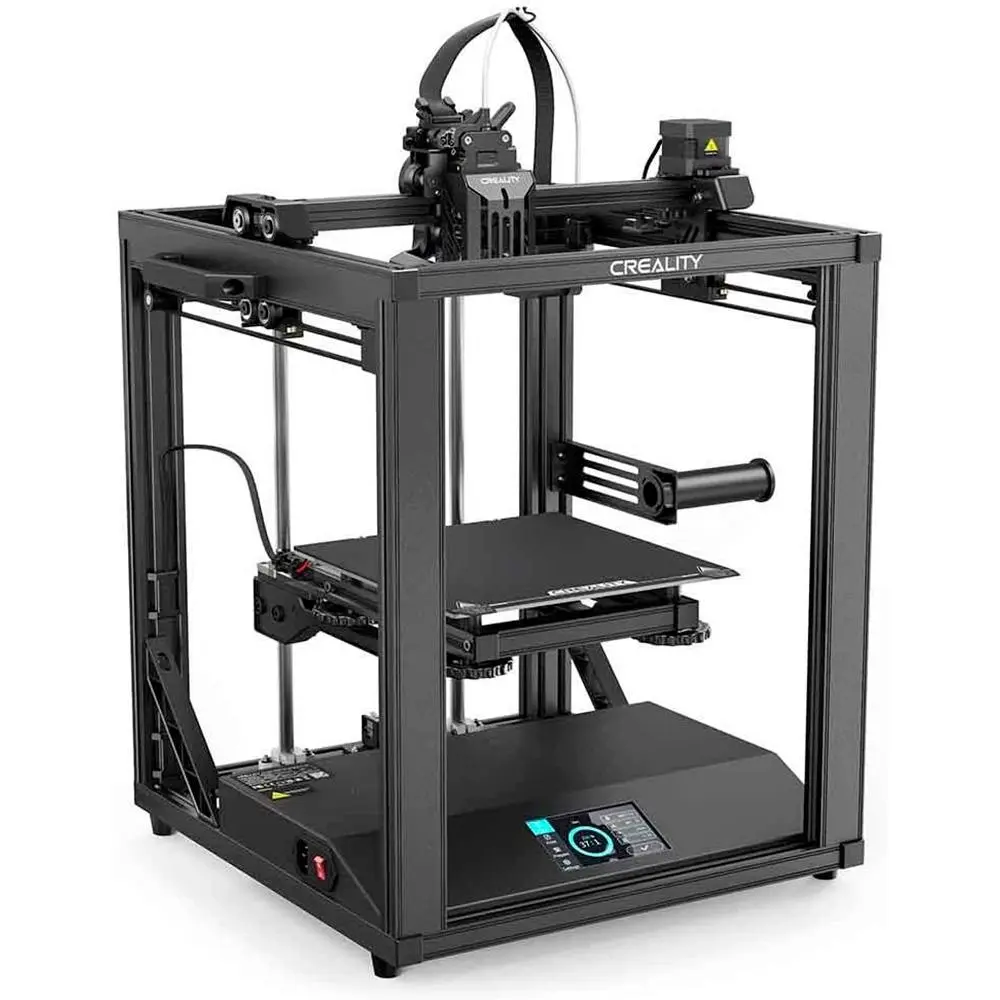Compare Ender 3 vs BIQU B1 vs Ender 5 S1
Comparison between the best 3D printers
Choose the best 3D printer at the best price. The cheapest 3D printers are here.
Buy a 3D printer here with 3D Fila.
 |
 |
 |
|
| Model | Ender 3[BUY Ender 3] |
BIQU B1 |
Ender 5 S1 |
| Printing Material | Filament | Filament | Filament |
| Estimated price | $210,00 | $269,00 | $467,00 |
| Fabricante | Creality 3D | BigTreeTech | Creality 3D |
| Release Year | 2018 | 2020 | 2022 |
| Print Volume [mm] | 220x220x250 | 235x235x270 | 220x220x280 |
| Printer Size [mm] | 440x440x465 | 412x402x492 | 425x460x570 |
| Weight [kg] | 6,62 | 8,00 | 12,1 |
| Power Loss Recovery | NO | YES | YES |
| Enclosed printer | NO | NO | NO |
| Bed Leveling | Manual | Manual | Automatic |
| Filament End Sensor | NO | YES | YES |
| Bed type | Heated | Heated | Heated |
| Power supply system | Bowden | Bowden | Direct Drive |
| Standard nozzle | 0,4 | 0,4 | 0,4 |
| Maximum Nozzle Temperature [°C] | 255 | 250 | 300 |
| Maximum Bed Temperature [°C] | 110 | 100 | 110 |
| Maximum printing speed [mm/s] | 180 | 100 | 250 |
| Filament holder | YES | YES | YES |
| Camera for supervision | NO | NO | NO |
| Recommended filaments | PLA, TPU, ABS, PETG | PLA, TPU, ABS, PETG | PLA, ABS, PETG, TPU, PC, ASA, HIPS |
| Recommended slicers | Cura, Simplify, Slic3r | Cura, Simplify, Slic3r | Cura, Simplify, Slic3r, IdeaMaker |
| Maximum Resolution [mm] | 0,1 | 0,1 | 0,05 |
| Processor | 8 bits | 32 Bits BTT SKR V 1.4 | 32 Bits |
| Display | Mono | Touchscreen TFT 3,5'' | Display touchscreen 4,3 '' |
| Power Supply | 24V / 270W | 24V / 360W | 350 W |
| Connectivity | SD / USB | SD / USB | SD / USB / Wi-Fi |
| Operating systems | Windows, Mac, Linux | Windows, Mac, Linux | Windows, Mac, Linux |
| Date of registration in the system | 2021-04-13 | 2021-04-14 | 2023-10-04 |
| Release date | 2018 | 2020 | 2022 |
| Extra features | The Ender 3 V1 is a DIY assembly 3D printer, a sales leader since 2017, standing out for its cost-benefit. With a wide printing capacity, it has a CNC machined structure for precision and stability. It offers high-precision prints with low noise, thanks to its innovative V-profile and pulleys. It has a self-adhesive magnetic platform for easy removal of models and excellent adhesion. The Ender 3 heats up quickly, reaching 100°C in 5 minutes, ideal for agile prints. It includes protection against power failures, allowing you to resume printing after interruptions, saving time and material. | The BIQU B1 is an advanced 3D printer with a silent 32-bit BTT SKR V1.4 motherboard and ARM Cortex-M3 CPU, offering DIY interfaces (I2C, SPI, WiFi) and dual Z-axis. Its dual BTT B1 TFT35 V3.0 operating system allows real-time monitoring and multiple printing modes, including G-code visualization effects. It stands out for its BIQU SSS (Super Spring Steel), ensuring easy model adhesion and simplified removal, with the possibility of using it on both sides. It includes a filament sensor, automatically pausing printing in case of filament breakage. The multicolored RGB lights integrated into the hotend allow you to view the printing status even at night. Additional notes include the need for a BIQU-specific Type-C cable and extra interfaces for smart filament sensor and BL Touch. | A steel drive shaft synchronizes the two Y-axis belts. High-torque 42-48 Y-axis motor for responsive and precise movement. Cartesian structure. Enhanced stability by thick linear shafts, extra stiffeners, two cantilevers, and silicone bumpers. Double Die Spring profile reinforcement. Silicone bed support. All-metal Sprite direct extruder. Best for printing with flexible filaments like TPU. Auto-calibration with 16-point CR Touch. Compatible with Sonic Pad, Wifi Box, and Camera kit. |
| Support for multiple colors and materials (AMS and CFS) | NO | NO | NO |
Notes * |
|||
| Cost-benefit | 6 / 10 | 7 / 10 | 7 / 10 |
| Hardware | 0.5 / 10 | 2 / 10 | 2.8 / 10 |
| Screen | . | . | . |
| Print volume | 3 / 10 | 3 / 10 | 3 / 10 |
| Performance | 1 / 10 | 1 / 10 | 2 / 10 |
| [BUY Ender 3] |
Conclusion |
| In comparing the three 3D printers—Ender 3, BIQU B1, and Ender 5 S1—several key factors emerge that help guide potential buyers in their decision-making process. **Price and Cost-Effectiveness:** The Ender 3 stands out as the most affordable option, making it accessible for hobbyists and beginners. Its cost-effectiveness is adequate for casual users who require basic printing capabilities. However, as the price increases with the BIQU B1 and Ender 5 S1, each presents enhanced features that justify the cost for more advanced users. **Print Volume and Performance:** All three printers have comparable print volumes, with slight variations. While the BIQU B1 offers a marginally larger print area, the Ender 5 S1 balances this with superior printing speed. Notably, the Ender 5 S1's potential to reach a higher maximum nozzle temperature also allows for printing a wider variety of materials. **Technology and Features:** The BIQU B1 and Ender 5 S1 incorporate advanced features such as power loss recovery, a filament end sensor, and automatic bed leveling, elevating their usability compared to the Ender 3. These features can significantly enhance the printing experience, especially in longer print jobs or when using flexible filaments. **Build Quality and Weight:** The Ender 5 S1 is the heaviest and potentially more stable option, suggesting a solid build that is likely to endure heavy use. In contrast, the Ender 3 and BIQU B1 are lighter, which might appeal to users seeking portability. **User Experience:** With touchscreen displays, the BIQU B1 and Ender 5 S1 clearly offer improved user interfaces over the more traditional mono display of the Ender 3. The integrated tools and sensors in the higher-priced models facilitate a smoother and more intuitive printing process. **Overall Recommendation:** For those on a budget or new to 3D printing, the Ender 3 remains a solid choice, providing essential features for entry-level printing. Conversely, if budget allows, the BIQU B1 and Ender 5 S1 present significant upgrades in technology and performance, appealing to users seeking enhanced capabilities and reliability in their printing experience. Ultimately, the decision should align with individual needs, such as budget constraints, desired features, and materials to be printed. |

